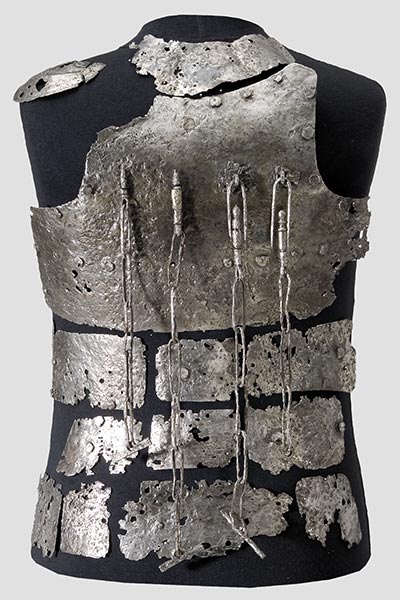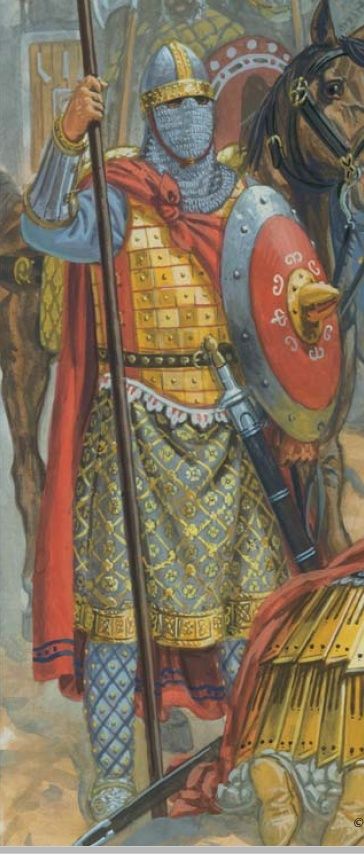| Author |
Message |
Pedro Paulo Gaião

|
|
  |
 |
|
James Moore
|
 Posted: Sun 10 Jan, 2016 2:49 pm Post subject: Posted: Sun 10 Jan, 2016 2:49 pm Post subject: |
 |
|
cant say much for the eastern European armour, but the other one, the oval shape for the breastplate is a bit odd (though I think I've seen it in art) but the chains are absolutely right. From what I've read, they were used to attach the dagger, a great-helm, etc. through the toggle-like bars at the end of the chains, so they couldn't be lost. No idea if it works, though.
An example of that sort was found in a dig about 10 years ago at Hirchstein Castle, in Germany. I think its now in a museum, Ingolstadt ,or Innsbruck, I think. ... something beginning with "I", at least.
I believe that Capwell might have written about it at some point.
 Attachment: 61.83 KB Attachment: 61.83 KB

example from Hirchstein castle, photo from Herman Historica auctions.
|
|
  |
 |
|
Mart Shearer
|
 Posted: Sun 10 Jan, 2016 3:02 pm Post subject: Posted: Sun 10 Jan, 2016 3:02 pm Post subject: |
 |
|
Bamberg Cathedral, c.1370:
http://effigiesandbrasses.com/742/4746/
http://effigiesandbrasses.com/743/1021/
The chains are, as noted, used for retention of both weapons and great helm. They can be attached to pairs of plates or aketons, numbering from 1-4. They appear in a number of 14th century inventories, sometimes being made of silver. The earliest instances of their use dates to the second decade of the 14th c..
As for the scale armor, it looks to be based upon the Cathedral of St. Lawrence, West Portal, Trogir Croatia carvings. The figures are near the top of the arch, and I haven't found a good photo, yet.
ferrum ferro acuitur et homo exacuit faciem amici sui
|
|
  |
 |
Dan Howard

|
 Posted: Mon 11 Jan, 2016 1:15 am Post subject: Posted: Mon 11 Jan, 2016 1:15 am Post subject: |
 |
|
Sometimes the chain was attached to the saddle. One tactic was to charge while wearing the great helm and then, after entering melee, this helmet was removed and the smaller helmet underneath was then relied upon. The chain was to make it easier to retrieve the helmet afterwards.
Author: Bronze Age Military Equipment, Pen and Sword Books
|
|
  |
 |
Pedro Paulo Gaião

|
 Posted: Wed 13 Jan, 2016 8:02 am Post subject: Posted: Wed 13 Jan, 2016 8:02 am Post subject: |
 |
|
| James Moore wrote: | An example of that sort was found in a dig about 10 years ago at Hirchstein Castle, in Germany. I think its now in a museum, Ingolstadt ,or Innsbruck, I think. ... something beginning with "I", at least.
I believe that Capwell might have written about it at some point. |
So, as far as we know, these oval-shape brestplates never left "Germany", right? The same with these chains?
The armor of your photo looks like a transition model between the brigandine and the cuirass. Of which century it belongs? Is it just me or are these chains in the back of the "corazzina", and not in the chest?
| Mart Shearer wrote: | | The chains are, as noted, used for retention of both weapons and great helm. They can be attached to pairs of plates or aketons, numbering from 1-4. They appear in a number of 14th century inventories, sometimes being made of silver. The earliest instances of their use dates to the second decade of the 14th c. |
These chains were ever used in fifteenth century?
-----------
Another armour that I had found in a plate of Osprey`s Book: "Byzantine Imperial Guardsmen 925–1025". I also found it here, the number 229

This could be the so called "Kuyak". It is rather unlikely because I had read that they only emerged in the thirteenth century, or that would be a mistake of mine?
|
|
  |
 |
|
Mart Shearer
|
 Posted: Wed 13 Jan, 2016 10:57 am Post subject: Posted: Wed 13 Jan, 2016 10:57 am Post subject: |
 |
|
The retention chains were used in England, France, and Italy as well, though they seemed to find more lasting popularity in German lands. There might be one or two examples from the first decade of the 15th century, but the chains are primarily a 14th century phenomenon.
http://effigiesandbrasses.com/search/?tags=%22chains%22
1311 Inventory of John fitz Marmaduke, Lord of Horden
j gaimbeson rubeum cum tribus cathenis argenteis l s.
1 red gambeson with three silver chains, 50s.
1313 Acquittance of goods seized from the captive, Piers Gaveston, Earl of Cornwall
Item, En un autre Coffre, une Peire de Plates, enclouez & garniz d'Argent, od quatre Cheynes d'Argent, coverz dun Drap de velvet vermail, besaunte d'Or.
Item, in another coffer, one pair of plates, nailed and garnished with silver, with four silver chains, covered in cloth of vermillion velvet, bezanty gold.
1327, England: http://manuscriptminiatures.com/5715/21385/
ferrum ferro acuitur et homo exacuit faciem amici sui
|
|
  |
 |
Dan Howard

|
 Posted: Wed 13 Jan, 2016 12:55 pm Post subject: Posted: Wed 13 Jan, 2016 12:55 pm Post subject: |
 |
|
Stop using Osprey. Most of the illustrations, especially the colour plates, are speculative fantasies. The books have some photos of extant artefacts that can be useful but not much else. Some Osprey books are very good such as the ones writtern by Graham Sumner, but they are the rare exception. Stick to books that employ footnotes and citations so you can confirm the veracity of the author's statements.
Author: Bronze Age Military Equipment, Pen and Sword Books
|
|
  |
 |
|
|
You cannot post new topics in this forum
You cannot reply to topics in this forum
You cannot edit your posts in this forum
You cannot delete your posts in this forum
You cannot vote in polls in this forum
You cannot attach files in this forum
You can download files in this forum
|
All contents © Copyright 2003-2025 myArmoury.com — All rights reserved
Discussion forums powered by phpBB © The phpBB Group
Switch to the Basic Low-bandwidth Version of the forum
|

